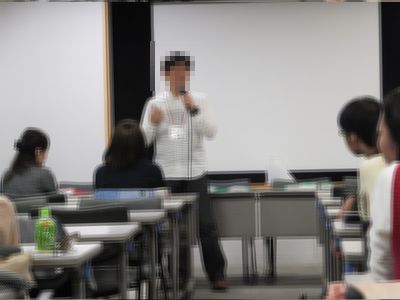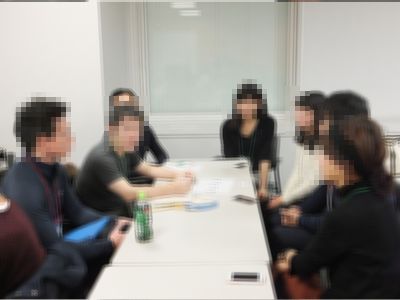1.新人の方の自己紹介

2.マテリアルの紹介 Sさん

3.会場の様子

:::::::::::::::::::::::::::::::::::::::::::::::::::::::::::::::::::::::::::::::
《 今回のworkshop 》
○workshop参加人数:59名(うち新人の方:1名)
○【前半】:Your Camera and Pictures
○【後半】:Public Pension system vs investment
:::::::::::::::::::::::::::::::::::::::::::::::::::::::::::::::::::::::::::::::::
みなさまこんにちは、E’s club幹事のKです。
11月19日(土)開催の第139回workshopの詳細をお送りいたします。
[今週のマテリアル]
≪FIRST HALF≫
Title: Your Camera and Pictures
移動メディア型のデジタルカメラ(Digital Still Camera)が1993年に富士フィルムより発売されて早くも20年、以降技術革新に伴い写真の質もアップし、当時は高級品であったカメラも今ではスマホの機能の一部になりました。写真は以前にも増して身近な物となり、SNSの普及に伴い一人当たりの写真撮影枚数も10年前に比較して4倍とも言われています。
今日は写真と自分と題して、自分にとってのカメラ、写真について熱く語り合ってみて下さい。
1) Do you have cameras? Single Lens Reflex type?, Mirror less type?
Compact Type or Smart phone?
2) Can you share the reason why you use those types of cameras you shared in question No.1?
3) How many pictures you take per day if you travel?
4) How do you enjoy pictures you taken before? With Album? or Just storage somewhere or to share on SNS?
5) Please share your No.1 Picture you took before, if you have time.
≪LATTER HALF≫
<Agenda>
Public Pension system vs investment
Pubic Government Investment Fund (PGIF) should do a safe investment or acquire maxim earnings by increasing stock ratio?
Let’s discuss our investment policy as to money for our old age.
<Reference 1>
GPIF(=年金積立金管理運用独立行政法人)とは
https://ja.wikipedia.org/wiki/%E5%B9%B4%E9%87%91%E7%A9%8D%E7%AB%8B%E9%87%91%E7%AE%A1%E7%90%86%E9%81%8B%E7%94%A8%E7%8B%AC%E7%AB%8B%E8%A1%8C%E6%94%BF%E6%B3%95%E4%BA%BA
確定拠出年金制度とは
https://ja.wikipedia.org/wiki/%E7%A2%BA%E5%AE%9A%E6%8B%A0%E5%87%BA%E5%B9%B4%E9%87%91
<Reference 2>
http://www.japantimes.co.jp/opinion/2016/05/30/commentary/japan-commentary/gpif-abode-demons/#.WCI6VFK7rIU
GPIF(Government Pension Investment Fund)が、収益率を上げるために株式への投資比率を上げた
GPIF: an abode of demons
If a house is to be made sturdy enough to withstand a major earthquake, it must be built on a solid foundation. This metaphor is analogous to the Japanese public pension system. The system, even though it invests a large amount of money, now stands on a very shaky foundation known as the Government Pension Investment Fund (GPIF).
In October 2014, the fund made a major review of the basic portfolio for its huge assets of ¥137.48 trillion by increasing the proportion of money invested in the more volatile stock market to 50 percent from the previous 25 percent.
But a worldwide stock price plunge in the ensuing year has given rise to a suspicion that the fund’s balance sheet for fiscal 2015, which ended last March, would fall into the red of more than 5 trillion yen.
At a session of the Lower House special committee on the Trans-Pacific Partnership accord on April 7, Yuichiro Tamaki of the opposition Democratic Party pressed welfare minister Yasuhisa Shiozaki to disclose during the current Diet session the fund’s profit-loss figures for the final quarter of the fiscal year or January through March 2016 if an early disclosure of details for the entire fiscal year was impossible.
The GPIF has in the past released relevant numbers for the previous fiscal year early in July as it is required by law to do so before the end of that month. For this year, however, the fund has announced that the disclosure will come on July 29 after the Upper House election.
This has drawn bitter criticism from the opposition parties, which suspect that the fund is trying to hide the huge deficit until after the election is over.
The statistics that the GPIF announces every quarter have already shown that it suffered a deficit of ¥500 billion during the first three quarters of fiscal 2015 or April through December 2015. In the July-September period in particular, the red-ink figure ballooned to ¥7.89 trillion.
If the balance for the final quarter is disclosed as was demanded by Tamaki, it will become clear whether the deficit for the whole fiscal year did indeed exceeded ¥5 trillion as has been suspected.
The GPIF customarily releases the numbers related to the final quarter of each fiscal year in a report covering the whole fiscal year, saying it needs to calculate details of commissions paid to trust banks and the performance of each asset administration organization. Shiozaki rejected an argument that the government decided to delay the announcement of the figures for the final quarter for election purposes by stating that it was the GPIF’s decision.
But in fiscal 2014, the commissions in question totaled only ¥29.1 billion — a mere 0.02 percent of the total investments and minuscule even when compared with the ¥15.29 trillion profits the GPIF earned for the year. Thus the alleged reason for delaying the disclosure of the final quarterly figures does not seem to stand to reason.
Since assuming his present post in September 2014, Shiozaki has endeavored to make the GPIF more autonomous, complaining that officials of his Health, Labor and Welfare Ministry have been meddling in the fund’s affairs. This may seem compatible with his stand that the fund should make its own decision on disclosure of the quarterly figures. Yet since he admits that the fund is in fact managed by the ministry, Shiozaki may not escape the blame for helping conceal the suspected huge losses.
Preventing political interventions was one of the purposes for restructuring the GPIF’s predecessor body in 2006 by giving it the status of an independent administrative agency. Prior to that, the fund had been known for providing posts for former welfare ministry officials to parachute down to and for being far from independent of the government. This is not unrelated to huge losses it had suffered from haphazard investments in resort facilities.
Even after the 2006 restructuring, however, little improvement has been seen in the organizational autonomy or transparency of the GPIF. In some cases, the government tried to use the fund’s assets to manipulate stock market prices.
The presidency of the GPIF has been assumed by people from outside the welfare ministry. Norihiro Takahashi, a former executive of Norinchukin Bank, is the current president. But one of the GPIF’s two directors is chosen from among ex-welfare ministry officials.
The GPIF is also understaffed. In Canada, whose population is one-third of Japan’s, the government pension fund has more than 500 workers. In contrast, the GPIF employs only about 80 workers, many of them on loan from the welfare ministry.
While the GPIF is structurally dependent on the ministry, the power to decide where to invest is concentrated in the hands of its president. Thus if anything goes wrong, the ministry will not be held accountable.
Attempting to improve the governance of the mega fund is the right thing to do as has been pointed out by some international organizations. But efforts for such improvement could become counterproductive if the wrong steps are taken.
A major error was committed when Prime Minister Shinzo Abe told the 2014 World Economic Forum in Davos, Switzerland, that he intended to utilize the GPIF for his growth strategy.
This gave rise to fears among certain quarters that Abe was trying to manipulate the stock market in an attempt to bring about the success of his Abenomics economic policy, that the government was intervening in corporate activities through the GPIF and that a sharp plunge in stock prices could lead to a collapse of the public pension system.
Increasing the weight of stocks in the GPIF’s portfolio is not a wrong move in itself because giving a lopsided weight to bonds is also risky. But the mistake is Abe’s international pledge to incorporate the GPIF into his growth strategy, which resulted in giving priority to reviewing its basic portfolio over reforming its governance. If a view spreads that the investment operation of the GPIF, which is an important source of income for senior citizens, has been changed with political considerations, the confidence in the pension system will be severely damaged. The top priority should have been given to elevating the autonomy of the GPIF.
A survey conducted by the Cabinet Office in 2010 showed that 90 percent of those polled did not know the results of the pension fund’s investment operation, indicating indifference on the part of the public and insufficient publicity efforts on the part of the government.
There is no need to react excessively to the ups and downs in the GPIF’s gains and losses. But if the fund is allowed to grow bigger without strengthening its foundation, it will become incapable of withstanding violent changes in the economic sphere.
Shiozaki tried to submit a legislative bill to reform Japan’s pension system, including reform of the GPIF, to the Diet by the end of 2015. But Abe stopped his move. Fearing that one of its provisions, a call for reducing pension benefits, might impact adversely the ruling coalition in the Upper House election, Abe and his aides decided to postpone the submission of the bill to the coming autumn when an extraordinary session of the Diet will be held.
Such populism will do nothing to strengthen the GPIF’s foundation. Moreover, efforts to reform it can come to naught if Shiozaki is replaced in the next Cabinet reshuffle.
The reform to increase the GPIF’s governance envisaged it making decisions through consensus of its directors by abolishing the current system under which power is concentrated on the president. But even if the reform is carried out, the welfare minister will select the directors without the consent of the Diet. This will make it possible for the welfare ministry to exert its influence over the GPIF. As was the case with its predecessor body, the GPIF is an abode of demons linked closely to the interests of politicians and bureaucrats.
<Questions>
Q1. Have you privately invested in any assets like stocks, bonds, real estate, or anything else? Why do you start or not start investment?
Q2. Are you satisfied with GPIF’s performance? Why?
Q3. GPIF (Government Pension Investment Fund) reformed their policy of investment and increased weights of stocks than before to get more profit. Do you agree with it, or not? Why? If you are disagree, what is a best portfolio for GPIF?
Q4. DC (Defined Contribution Plan) will be revised in January 2017, and almost all adults can join DC. Do you already join it? Or, do you want to start? What is the merit of DC?
Q5. If you are 35 years old and start investment for the first time with your 1 million yen, what is your best portfolio?
25 years later, how much total assets do you want?
Please select assets from following 4 assets and make presentation in your group.
(1) Japanese stocks (middle risks)
Expected rate of return is 5% (per year).
Risk (possible volatility) is ±20%.
(2) Japanese bonds (low risks)
Expected rate of return is 0.2% (per year).
Risk (possible volatility) is ±1%.
(3) Foreign stocks (high risks)
Expected rate of return is 15% (per year).
Risk (possible volatility) is ±30%.
(4) Foreign bonds (middle risks)
Expected rate of return is 3% (per year).
Risk (possible volatility) is ±10%.